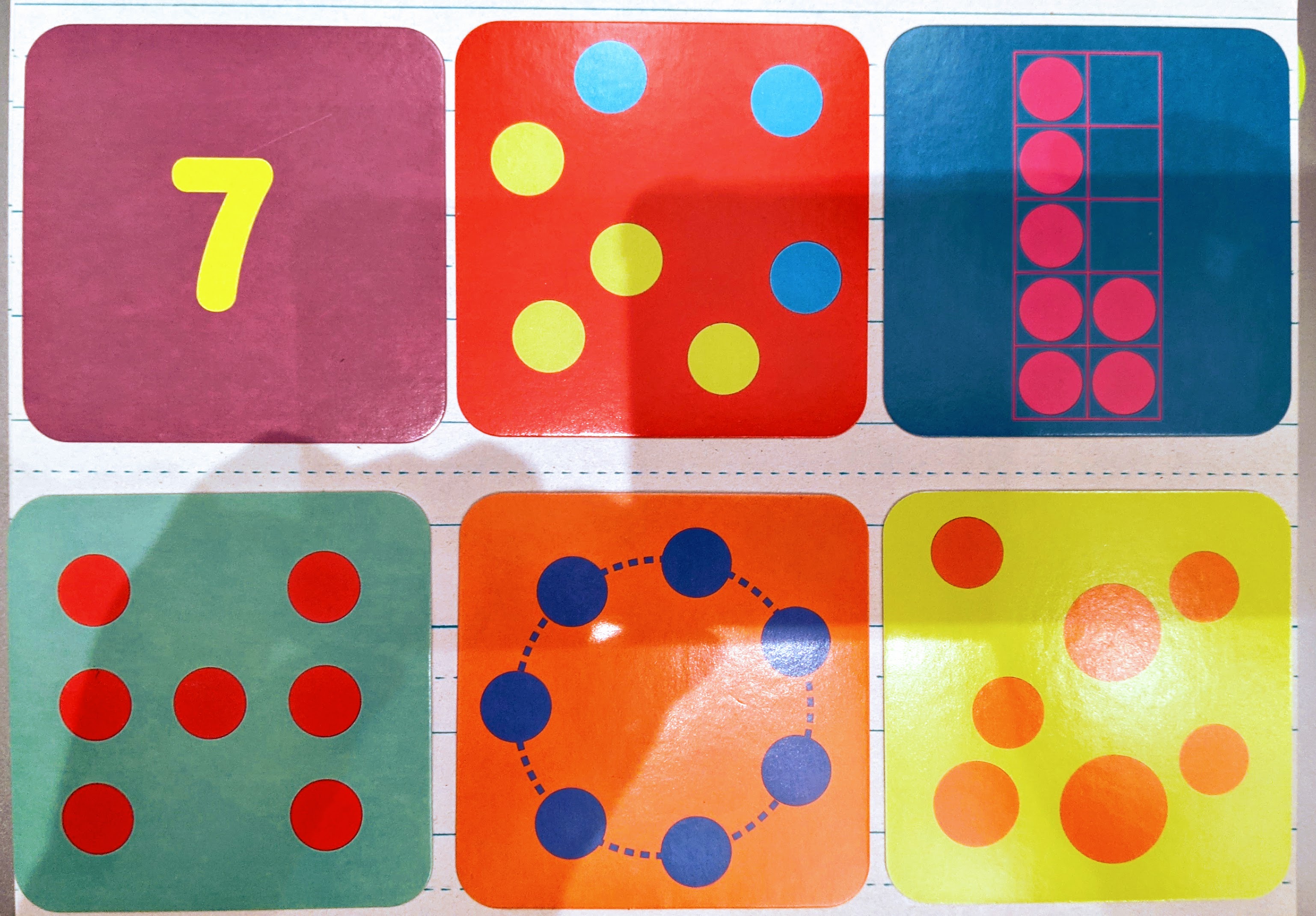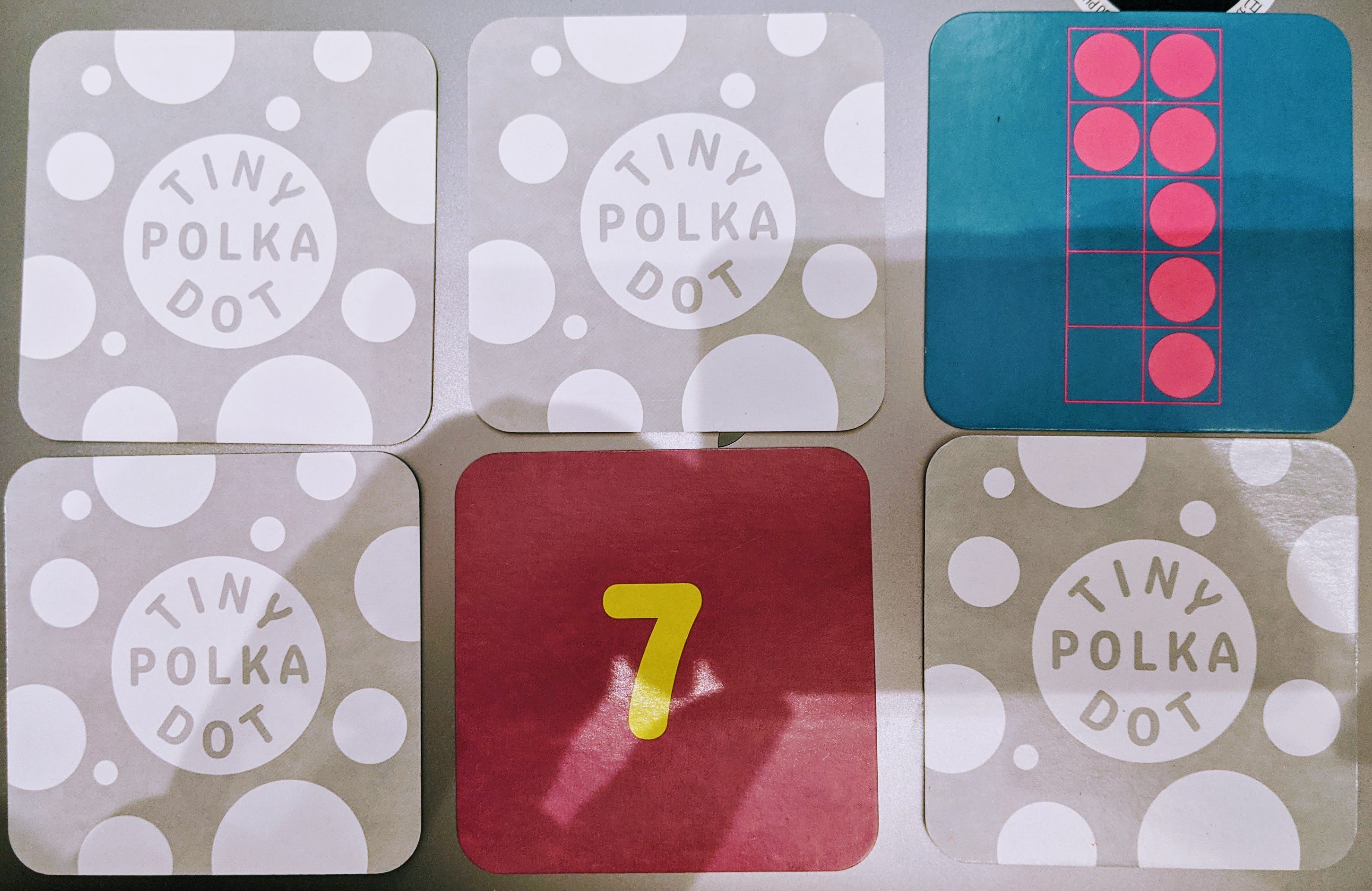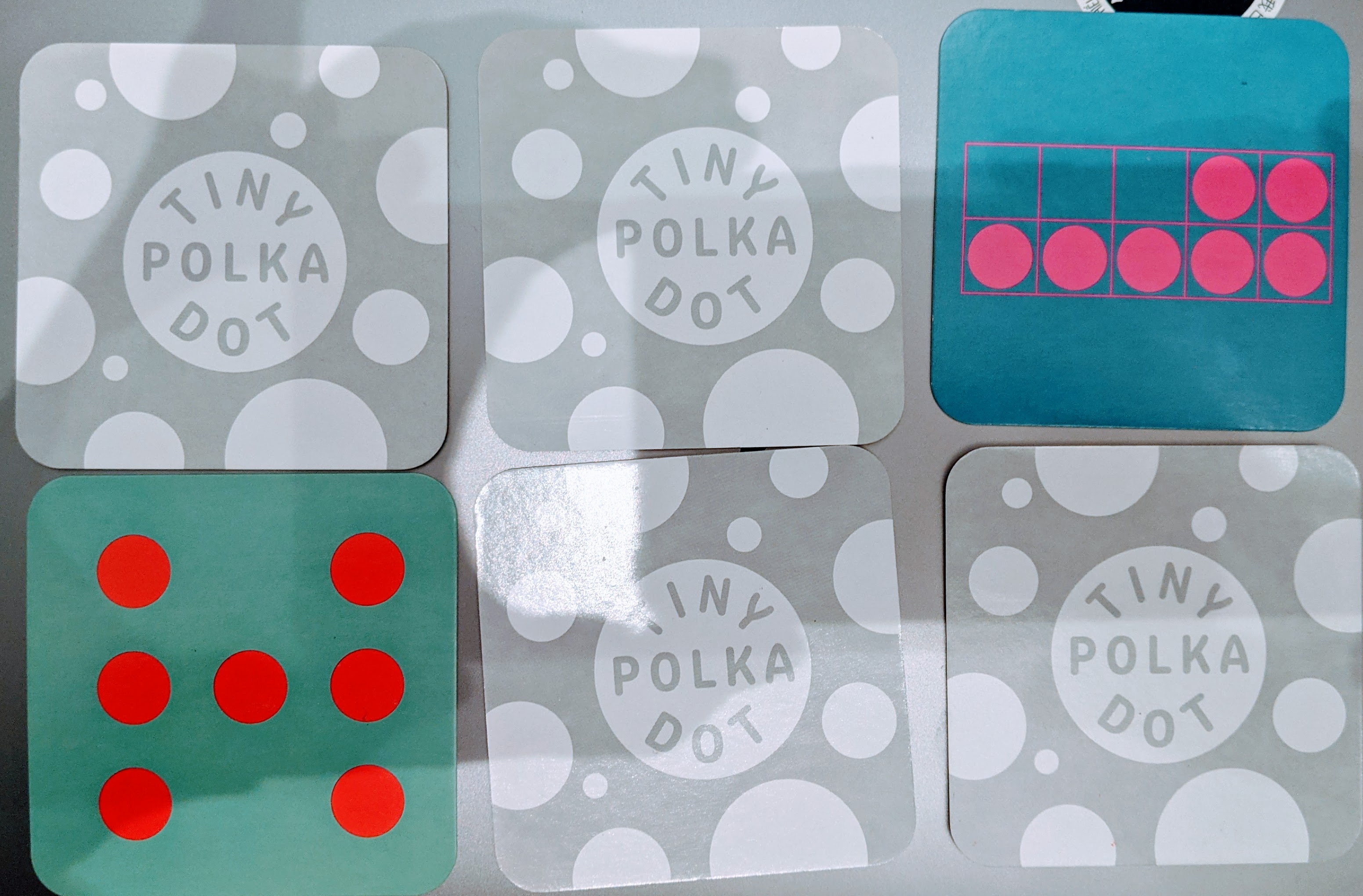The award winning game Tiny Polka Dot by Math for Love is anything but a single game, rather its a deck of multiple representations of the numbers zero to ten with limitless possibilities. As a mathematics educator I have found the decks useful to share with my students (who are future elementary school teachers) mostly around how they support various aspects of developing number sense, promote numeral recognition, and provide opportunities to learn a variety of mathematics concepts and habits of mind through games.

Rather than give a comprehensive overview of all the things you can do to teach with a Tiny Polka Dot game in your hand, I will share a little bit about how I have been reaching for the deck to do spontaneous game play to support the mathematical topics my first grade son is learning about through crisis distance learning. And along the way, make a little sense of how I select which representations and why.
I’m a firm believer in playing games to learn, and in having the right tools for the job. The Tiny Polka Dots deck is can be a useful tool for parents, for spontaneous game play that reenforces emerging concepts, and for more target game play to help children make sense of strategies new to them.
Fun with Quick Images
One way I use the deck spontaneously is as a resource for cards with multiple useful representations of numbers 0-10. Yay to not having to search the internets for the images we want, right? So we aren’t always playing a game against each other with rules or points. Sometimes, I select a type of representation, a random number, and I flash the card and my son has to tell me how many dots he saw (it’s a variation on quick images or dot talks, you can see this resource from youcubed.org if you aren’t familiar with them.) This purposeful selection of the representation of the number helps scaffold the activity, and in some cases increase or decrease the challenge by either providing structure for the student to make sense of and use to subitize, or provide a more free-from representation that the student has to impose a structure on or make sense of. I like to use the blue deck to help my son get familiar with how to use the structure of the ten frame to subitize (ie, notice and make use of structure, like the math practice says). Other times I use the red deck because the different colored dots suggest groupings but don’t organize the dots into arrays, so he has to think a little more about how to describe what he saw.

Fun with Addition Strategies
Another way I use the deck is to play familiar games with intentionally-chosen representations of numbers, to support emerging concepts. Right now, they are learning about the strategy of using near doubles to solve their addition number facts. From my eaves-dropping during the zoom class, I gather that this feels like a leap to a lot of the students, who are most comfortable using counting-on strategies (putting one number in their head, and counting up from it until they’ve counting up by the second number.) One way I see this showing up in my son is ask him to solve any small addition problem like 4 + 5, and he will put up 5 fingers say “four” and then count up from there putting one finger down each time. “Four, .. five, six, seven, eight, nine. It’s nine.” The teacher also has acknowledge that this strategy might seem weird or hard at first. I won’t get into my views on how and when to introduce different strategies for addition, because that’s not important. In the curriculum the teacher is following, this is the next major strategy introduced.
But surprise surprise, my son, and my guess is a lot of the other students, aren’t yet buying this idea that your doubles are good to know at the recall level (meaning you have a strategy to figure it out accurately or have solved this problem so many times you just know the answer). Not when counting on works so well.1 So I play this memory game with him to encourage familiarity with the doubles, so that maybe he will get to the point where he has automaticity with his doubles. But we are leaning on his counting-on strategy as the means to the automaticity, that is to say he is invited to figure out the solution however he wants but I am going to select representations of numbers that explicitly support a counting on strategy.
We start by collecting the eleven cards that make up the blue ten-frame deck, and the 11 cards that make up the purple numeral deck. We shuffle up these 22 cards and lay them out, just like any other game of memory. On your turn, you flip to cards. If it’s not a match, you say the numbers you got anyway and then flip them back over. If the numbers match, you say the total, and get that many points. I prompt my son to say it as an equation: “6 plus 6 equals 12” but I don’t make a big deal out of it. It’s not the point of our game.
Whenever I get a match I offer my son a chance to steal. I call out the match, but I ask if he can find the total he can have my points. So far, this works occasionally. For example, he took me up on 8 plus 8, but didn’t for 7 plus 7. When I have to solve the double, I take the opportunity to model my thinking aloud that mirrors how to use the near doubles ideas: “well, 7 + 7 is hard for me. I try to think of it like 5 plus 5 is 10, and 6 plus 6 is 12, and so 7 + 7 is 14. Yup, fits the pattern.” When my son is figuring it out, for the ones that aren’t yet automatic he uses a counting on strategy. Here is where the representation of the numbers matters, since for any pair of doubles in our game one part is “countable” (ie, the dots in the ten frame can be counting by ones) and other is not (ie, the numeral which is standing in for an amount). This representation signals to him to hold the numeral in his head and count on.

Let’s contrast that with a memory game in which students are matching, say, the representations of numbers in the ten frame (the blue cards) with the domino-like representations (the teal cards) (see image below). In this case, a pair is a match of the same amount in the blue and teal decks. Also, every dot is represented so you could count all or count on or use any other strategy that comes to you after you name the amounts. This is a good variation of the game to play with students who would like to be able to count by ones (or count all) as a strategy. It doesn’t suggest the counting on strategy in the same way as the version we play with the numeral deck since children can see all the dots that make up the solution. Also, children may have to count the dots on each card (by ones, subitizing, combinations of subitizing and counting on, etc) to say how much is on each card, and then solve from there, whereas with the numeral card version they are encouraged to rely on numeral recognition and familiarity with ten-frame numbers to determine if the cards are a match.

Notice I’m not saying one combination of decks is better or worse than the other. Instead, I like to emphasize the intention. What’s the goal? To have fun? Maybe randomly select two types of decks. To see if you can nudge your kiddo in the direction of a particular strategy like counting on? Maybe have one deck be numerals, the other any other deck. To practice multiple addends? Add a third deck. To practice doubles? You can try the version described above and see what happens when you change one of the deck types. I would try it a few ways. As a fun exercise you can ask yourself, what cards would I select and what rules of the game would we use if my hope was to support making tens (ie, finding pairs of numbers that add up to 10)?
Parents, no version of the game is going to mess up your kid. Rather, all games that the Tiny Polka Dot decks support are an opportunity for fun and enriching math in the home. There’s no cheating or penalties in math games we play with our kids. There’s really only fun, light hearted conversation, curiosity, and love.
Do you have a Tiny Polka Dots deck at home? Or teachers, are you finding ways to play the games with your students even during crisis distance learning? Drop me a line!
————
1 If you are wondering why we would ask kids to get familiar and comfortable with different methods for addition when one way seems to be working fine for them, the answer may be in the vast landscape of number sense and what it means to be a flexible thinker. To learn more about this terrain, you might enjoy Graham Fletcher’s series on making sense of addition and subtraction: https://youtu.be/nRGZSc1Qvng
